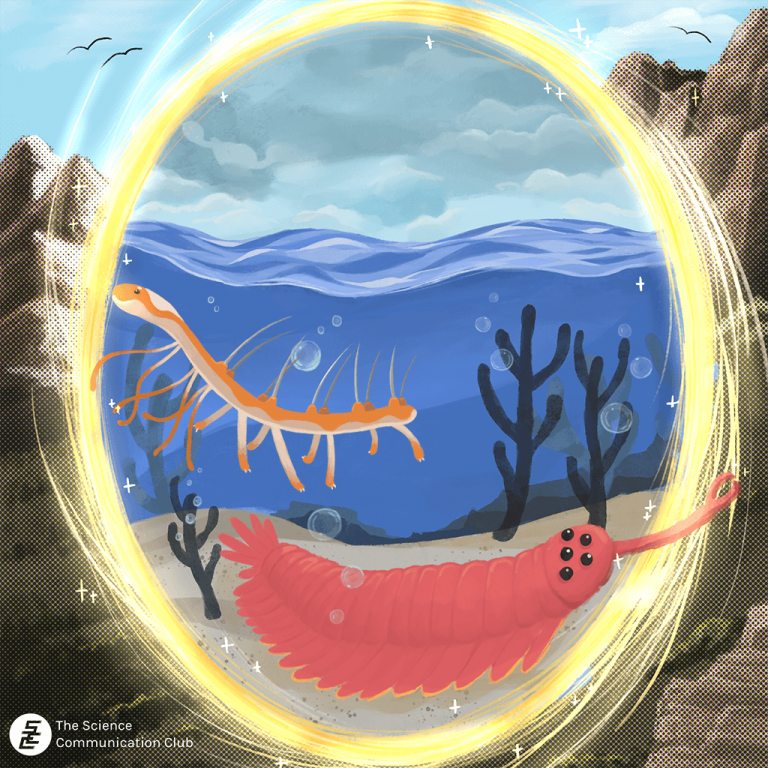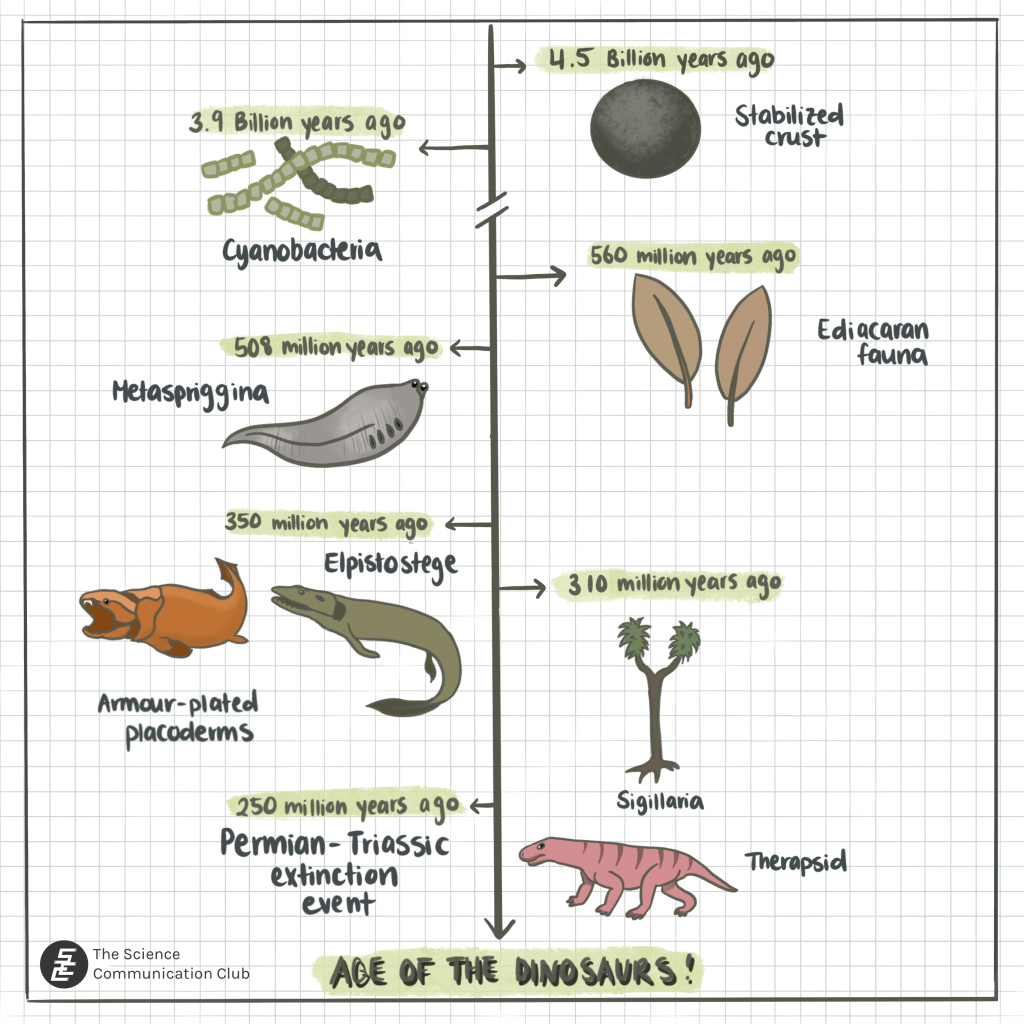
Written by Alejandro Izquierdo Lopez
Illustrated by Juliet Ko
Imagine being able to time travel back to 4.3 billion years ago, witnessing for yourself the origin of life. Your time machine then takes you through the main episodes of Earth’s history, allowing you to see the planet changing and life evolving. Finally, at 250 million years into the past, just before the start of the age of the dinosaurs, your journey ends.
This time machine is, in fact, the Royal Ontario Museum. From December 4th this year, you’ll be able to experience the brand new Willner Madge Gallery, Dawn of Life. This is a permanent exhibit at the heart of the ROM, showcasing the early evolution of life through art, interactive displays and, undoubtedly, fossils. These fossils were discovered in some of the best paleontological sites in Canada and the world, many of them UNESCO World Heritage Sites. Most of them have been kept deep inside the collections at the ROM and other museums, only accessible for research—until now. Let me give you a first glimpse of this journey.
Around 4.5 billion years ago, Earth’s outer shell, the crust, stabilized. With the formation of oceans of water, Earth was the perfect candidate for life to appear on. Some estimates calculate that life likely began not long after Earth’s formation. Others point out that life would have appeared only after meteorite showers ceased, around 3.9 billion years ago. Although it is not clear when life began, we do know that the first inhabitants of Earth were unicellular organisms such as bacteria, which used compounds dissolved in water as a source of energy. One group of bacteria, the cyanobacteria, could use water and sunlight as their sources of energy instead, producing oxygen in return. Dating back to around this time, the red rocks of Inukjuak in Québec are some of the oldest rocks in the world. They show, for the first time, black layers of iron, which geologists think is a sign that ocean chemistry had started to change dramatically.
Cyanobacteria soon dominated the sea, creating an oxygen-rich planet which would become fundamental for life to come. The billion-year-old stromatolite rocks from the Northwest Territories are an example of this new planet. These were created by cyanobacteria, which produce a glue-like compound that clusters them and attaches them to surfaces. Minerals can also get trapped, slowly forming the layered stromatolite rock.
After that, we have little understanding of how life evolved, so we have to jump ahead several hundred million years. At the Mistaken Point site in Newfoundland and Labrador, 560-million-year-old rocks show something extraordinary: the Ediacaran fauna, the first complex, macroscopic organisms. They coincide with our estimations of the earliest animals; however, most of them have uniquely structured bodies and are unclassifiable within our current animal groups. Not long after, though—around 508 million years ago—this scenery changes completely. The rocks at the Burgess Shale formation at British Columbia show an abundance of exquisitely preserved animals. Among them, many have become famous for their bizarre adaptations: the five-eyed Opabinia with a trunk-claw; Hallucigenia, a worm with spines; and the spine-plated Wiwaxia, just to name a few. These represent the first ancestors of the main animal groups we know today, such as the arthropods, like shrimp and spiders; or molluscs, like octopi and snails. Among them, there is also the fish-like Metaspriggina, one of the first vertebrates we know of.
For the next hundred million years, animals like the armoured, pill bug-like trilobites or the sea lilies (crinoids) would dominate the seas, shown by a rich fossil record from Ontario. Marine ecosystems became increasingly more complex, and at 350 million years ago, a new player would completely change the scenery once again: fish. The Age of Fishes began, shown by the exquisite fossils from Miguasha in Québec. Fishes diversified into many groups. Some were the ancestors of our current fish groups, such as bony fishes and cartilaginous fishes, while others, like the armour-plated placoderms, would eventually go extinct.
While the seas were already booming with life, the conquest for land was significantly slower. By the Age of Fishes, land contained mostly mosses, fern-like plants, and arthropods, as well as amphibians like Elpistostege, some of the first land-dwelling vertebrates we know of. The 380-million-year-old fossils from Joggins in Nova Scotia show us an additional revolution to this terrestrial landscape: three-dimensionally preserved trunks from the first trees, the fern-like Sigillaria. Plants and vertebrates would soon create new ecosystems that would spread across the land. This increased Earth’s oxygen levels for a short time, allowing land insects or spiders to grow to gigantic sizes.

This trip, though, is close to its end. Around 250 million years ago, the most severe extinction we know of happened: the Permian-Triassic extinction event. Around 80% of all species went extinct. But life continued, and the survivors took advantage of a new Earth. The reptile-like therapsid and diapsids diversified and would respectively give rise to the mammals and all modern groups of reptiles. Other reptile groups would eventually go extinct, like the marine fish-like ichthyosaurs found close to Williston Lake in British Columbia. On land, the age of the dinosaurs started.
You can already experience the second part of this journey at the ROM. To experience the first part in its totality and see the world-renowned fossils firsthand, mark your calendars for December 4th.
Sources:
- Pearce, B. K., Tupper, A. S., Pudritz, R. E., & Higgs, P. G. (2018). Constraining the time interval for the origin of life on Earth. Astrobiology, 18(3), 343-364.
- Mloszewska, A. M., Pecoits, E., Cates, N. L., Mojzsis, S. J., O’Neil, J., Robbins, L. J., & Konhauser, K. O. (2012). The composition of Earth’s oldest iron formations: the Nuvvuagittuq Supracrustal Belt (Québec, Canada). Earth and Planetary Science Letters, 317, 331-342.
- Hoffman, P. (1974). Shallow and deepwater stromatolites in Lower Proterozoic platform–to–basin facies change, Great Slave Lake, Canada. AAPG Bulletin, 58(5), 856-867.
- Matthews, J. J., Liu, A. G., Yang, C., McIlroy, D., Levell, B., & Condon, D. J. (2021). A chronostratigraphic framework for the rise of the Ediacaran macrobiota: new constraints from Mistaken Point Ecological Reserve, Newfoundland. Bulletin, 133(3-4), 612-624.
- Bobrovskiy, I., Hope, J. M., Ivantsov, A., Nettersheim, B. J., Hallmann, C., & Brocks, J. J. (2018). Ancient steroids establish the Ediacaran fossil Dickinsonia as one of the earliest animals. Science, 361(6408), 1246-1249.
- Gould, S. J. (1990). Wonderful life: the Burgess Shale and the nature of history. WW Norton & Company.
- von Bitter, P. H., Purnell, M. A., Tetreault, D. K., & Stott, C. A. (2007). Eramosa Lagerstätte—Exceptionally preserved soft-bodied biotas with shallow-marine shelly and bioturbating organisms (Silurian, Ontario, Canada). Geology, 35(10), 879-882.
- Claudino-Sales, V. (2019). Miguasha National Park, Canada. In Coastal World Heritage Sites (pp. 113-118). Springer, Dordrecht.
- Falcon-Lang, H. J., Benton, M. J., Braddy, S. J., & Davies, S. J. (2006). The Pennsylvanian tropical biome reconstructed from the Joggins Formation of nova Scotia, Canada. Journal of the Geological Society, 163(3), 561-576.